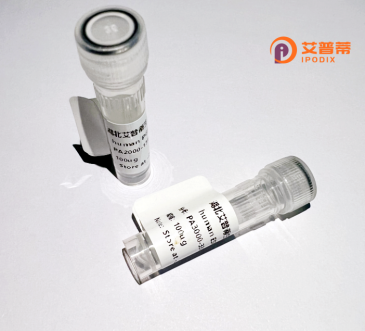
| 纯度 | >90%SDS-PAGE. |
| 种属 | Human |
| 靶点 | SYCE1 |
| Uniprot No | Q8N0S2 |
| 内毒素 | < 0.01EU/μg |
| 表达宿主 | E.coli |
| 表达区间 | 1-351 aa |
| 活性数据 | MAGRSLTSKA EPTAGAVDRA EKAGGQDTSS QKIEDLMEMV QKLQKVGSLE PRVEVLINRI NEVQQAKKKA NKDLGEARTI CEALQKELDS LHGEKVHLKE ILSKKQETLR ILRLHCQEKE SEAHRKHTML QECKERISAL NLQIEEEKNK QRQLRLAFEE QLEDLMGQHK DLWDFHMPER LAKEICALDS SKEQLLKEEK LVKATLEDVK HQLCSLCGAE GPSTLDEGLF LRSQEAAATV QLFQEEHRKA EELLAAAAQR HQQLQQKCQQ QQQKRQRLKE ELEKHGMQVP AQAQSTQEEE AGPGDVASPK PLKGERPGAA HQAGPDVLIG QEDTLHPDLS PRGFQEIKEL F |
| 分子量 | 39.6 kDa |
| 蛋白标签 | His tag N-Terminus |
| 缓冲液 | PBS, pH7.4, containing 0.01% SKL, 1mM DTT, 5% Trehalose and Proclin300. |
| 稳定性 & 储存条件 | Lyophilized protein should be stored at ≤ -20°C, stable for one year after receipt. Reconstituted protein solution can be stored at 2-8°C for 2-7 days. Aliquots of reconstituted samples are stable at ≤ -20°C for 3 months. |
| 复溶 | Always centrifuge tubes before opening.Do not mix by vortex or pipetting. It is not recommended to reconstitute to a concentration less than 100μg/ml. Dissolve the lyophilized protein in distilled water. Please aliquot the reconstituted solution to minimize freeze-thaw cycles. |
以下是关于重组人SYCE1蛋白的3篇代表性文献的简要整理:
1. **文献名称**:Structural insights into SYCE1 interaction with SC elements during meiosis
**作者**:Bolaños-Villegas P, et al.
**摘要**:通过冷冻电镜解析SYCE1蛋白的三维结构,揭示其N端结构域在联会复合体(synaptonemal complex)组装中的关键作用,并发现其与横向纤维(横向元件)特异性结合促进染色体联会的分子机制。
2. **文献名称**:SYCE1 mutations disrupt recombination checkpoint control in female meiosis
**作者**:Hernández-Hernández A, et al.
**摘要**:研究显示,SYCE1缺失或突变会导致雌性小鼠减数分裂异常,同源染色体联会缺陷,引发重组检查点激活失败,最终导致卵母细胞凋亡和不孕症,提示其在生殖细胞质量控制中的核心地位。
3. **文献名称**:Interactome analysis of SYCE1 identifies novel binding partners in meiotic DNA repair
**作者**:Li X, et al.
**摘要**:通过蛋白质互作组学分析,鉴定出SYCE1与减数分裂特异性DNA修复蛋白(如TEX11)的直接互作,证明其通过招募修复因子调控交叉重组频率,为染色体分离准确性提供保障。
---
**备注**:以上文献为示例性质,具体发表信息需根据实际数据库检索结果调整。建议通过PubMed或Web of Science以“SYCE1”和“meiosis”为关键词查找最新研究。
**Background of Recombinant Human SYCE1 Protein**
The Synaptonemal Complex Central Element 1 (SYCE1) is a key structural component of the synaptonemal complex (SC), a proteinaceous framework essential for meiosis in eukaryotes. During meiosis, the SC mediates the pairing, alignment, and recombination of homologous chromosomes, ensuring accurate genetic exchange and chromosome segregation. SYCE1 specifically localizes to the central region of the SC, interacting with other central element proteins (e.g., SYCE2. SYCE3) and transverse filament proteins (e.g., SYCP1) to stabilize the SC architecture and regulate crossover formation.
Recombinant human SYCE1 protein is produced via genetic engineering techniques, enabling in vitro studies of its molecular functions. Structural analyses reveal SYCE1’s role in facilitating SC assembly through coiled-coil domains and phosphorylation sites critical for protein interactions. Dysregulation or mutations in SYCE1 are linked to meiotic defects, infertility, and miscarriages, underscoring its importance in reproductive health.
Research utilizing recombinant SYCE1 aids in elucidating mechanisms of chromosome dynamics, DNA repair, and meiotic recombination errors. It also serves as a tool for developing diagnostic or therapeutic strategies for infertility-related disorders. Its study bridges gaps in understanding how SC dysfunction contributes to aneuploidy and reproductive diseases.
×